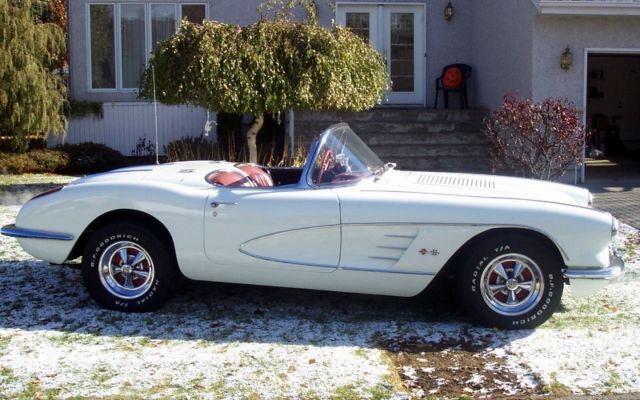

The engine's output was increased to 150 hp (110 kW) via a Carter triple-carburetor system exclusive to the Corvette, but performance of the car was decidedly "lackluster". Underneath the new body material were standard components from Chevrolet's regular car line, including the "Blue Flame" inline six-cylinder engine, two-speed Powerglide automatic transmission, and drum brakes.
#1958 corvette soft top installation license#
Furthermore, information being given to us by the reinforced plastic industry seemed to indicate the practicality of fabricating plastic body parts for automobiles on a large scale.Ī 55-degree raked windshield was made of safety glass, while the license plate holder was set back in the trunk, covered with a plastic window. People seemed to be captivated by the idea of the fiberglass plastic body. It was some time later that we decided to produce this quantity in reinforced plastic.Ībout this time, some doubt was expressed that we should build the 1954 model of steel. The body on the show model was made of reinforced plastic purely as an expedient to get the job done quickly.Īlthough we were going ahead with the building of an experimental plastic body in order to get a car rolling for chassis development work – at the time of the Waldorf Show, we were actually concentrating body-design-wise on a steel body utilizing Kirksite tooling for the projected production of 10,000 units during the 1954 model year. Several excerpts highlight some of the key points in the body material choice: He presented a paper to the Society of Automotive Engineers in 1954 regarding the development of the body. The body engineer for the Corvette was Ellis James Premo. In calendar years 19 Chevrolet produced nearly 2 million steel-bodied full-size passenger cars and the intended production volume of 10,000 Corvette for 1954 was only a small fraction of that. Although steel shortages or quotas are sometimes mentioned as a factor in the decision to use fiberglass, no evidence exists to support this. The outer body was made out of then-revolutionary glass fiber reinforced plastic material. ĭuring the last half of 1953, 300 Corvettes were to a large degree, hand-built on a makeshift assembly line that was installed in an old truck plant in Flint, Michigan while a factory was being prepped for a full-scale 1954 production run. The roadster was built as the Corvette, the Corvair fastback variant never went in production, and two-door Nomad station wagon was eventually built as the Chevrolet Nomad.
#1958 corvette soft top installation manual#
Because there was currently no manual transmission available to Chevrolet rated to handle 150 HP, a two-speed Powerglide automatic was used. Output was 150 horsepower (110 kilowatts). The engine was a 235 cu in (3.85 L) inline six engine that was similar to the 235 engine that powered all other Chevrolet car models, but with a higher-compression ratio, three Carter side-draft carburetors, mechanical lifters, and a higher-lift camshaft. The drivetrain and passenger compartment were moved rearward to achieve a 53/47 front-to-rear weight distribution. McLean mandated off-the-shelf mechanical components, and used the chassis and suspension design from the 1949–1954 Chevrolet passenger vehicles. To keep costs down, GM executive Robert F. The EX-122 car is now located at the Kerbeck Corvette museum in Atlantic City and is believed to be the oldest Corvette in existence. When production began six months later, at an MSRP of US$3,513 ($35,580 in 2021 dollars ), it had evolved into a considerably costlier car than the basic $2,000 roadster Harley Earl originally had in mind. The result was the hand-built, EX-122 pre-production Corvette prototype, which was first shown to the public at the 1953 General Motors Motorama at the Waldorf-Astoria in New York City on January 17, 1953. The secretive effort was code-named "Project Opel" (after GM's German division Opel).

The last time Chevrolet offered a 2-door, 2-passenger convertible/roadster body style was in 1938 with the Chevrolet Master. Earl convinced GM that they needed to build an all-American two-seat sports car, and with his Special Projects crew began working on the new car in late 1951. In 1951, Nash Motors began selling an expensive two-seat sports car, the Nash-Healey, that was made in partnership with the Italian designer Pininfarina and British auto engineer Donald Healey, but there were few moderate-priced models. He recognized that GIs returning after serving overseas in the years following World War II were bringing home MGs, Jaguars, and Alfa Romeos. Harley Earl, as head of GM's Styling Section, was an avid fan of sporting cars.


 0 kommentar(er)
0 kommentar(er)
